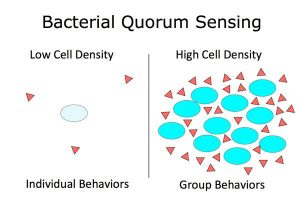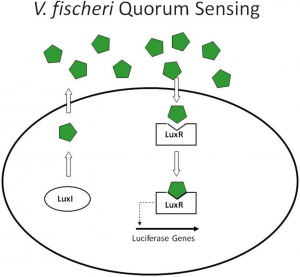- Sensing quorum is a form of decision-making mechanism used for the organisation of actions among decentralised communities. Many bacterial organisms use quorum sensing to co-ordinate their gene expression with their population’s local density.
- Likewise, some social insects make mutual decisions about where to nest by way of quorum sensing. Quorum sensing has many uses for computation and robotics, as well as its role in biological systems.
- Quorum sensing can work in any decentralised system as a decision-making mechanism, providing that each component (a) has a means to determine the number of other elements with which it interacts and (b) a standard response until a threshold of component has been removed.

Bacteria
- Some of the most common examples of quorum sensing are bacteria experiments. To coordinate those activities depending on the local bacterial population density, bacteria use quorum sensing.
- Quorum sensing can occur both within one particular bacterial species and between various species and can monitor a number of processes, acting mainly as a basic network of communication.
- Various compounds may be used as signals.
Mechanism
- Bacteria that use quorum sensing constantly generate and secrete some signalling molecules (called auto-inductors or pheromones)
- They also have a receptor which can sense the signalling molecule (inducer) in particular.
- When the inducer binds to the receptor, the transcription of certain genes is activated, including those for inducing synthesis.
- A bacterium that detects its own secreted Acetyl-Homoserine Lactone (AHL) is poor in chance. Thus the cell must experience signalling molecules secreted by other cells in its surroundings in order for gene transcription to be triggered.
- When only a few other bacteria of the same type are in the vicinity, diffusion decreases the inducer concentration in the local medium to almost zero.
- However, with the population increasing, the inducer concentration crosses a threshold and synthesises further inductors. The receptor is fully activated and forms a positive feedback loop.
- The receptor activation triggers the increase in regulation of other particular genes and allows all cells at around the same time to start transcription.
- In different conditions, this co-ordinated bacterial cell activity may be beneficial. For eg, if it were generated by a single cell, the bioluminescent luciferase generated by V. fischeri would not be visible.
- V. fischeri cells can inhibit energy consumption by using quorum sensing to restrict luciferase production to conditions where cell populations are high and can avoid manufacturing useless products.
Examples
1. Vibrio fischeri: In Vibrio fischeri, a bioluminiscent bacterium which lives in the photophore (or lightproducing organ) of the Hawaiian squid, a mutualist symbiont, a Quorum sensing was observed first. When fischeri cells live freely (or planktonically), the self-inducer is poor and cells are not luminescent. However, if the photophores (about 1011 cells / ml) are extremely concentrated, luciferase transcription leads to bioluminescence.

2. Escherichia coli: Cell division can be partly regulated by the Auto-Inducer (AI-2), mediated quorum sensing, in Escherichia coli Gram-negative bacteria. This species uses AI-2, which the lsr operon generates and processes. This involves an ABC carrier that imports AI-2 in cells in the early stationary (latent) growth process. The freshly producted phosphoAI-2 can either be internalised or used to remove LsrR, a lsr operon repressor (by activating the operon). Lsr-2 is then phosphorylated by LsrK kinase. Dihydroxyacetone phosphate (DHAP) prevents transcription of the lsr operon by its competitive binding with LsrR. It has been shown that glyceraldehyde 3-phosphate activates the lsr operon by inhibiting cAMP-CAPK. This is the reason why E. coli when grown with glucose lose the ability to internalise AI-2 (catabolite repression) The AI-2 involvement is temporary when developed normally.
3. Pseudomonas aeruginosa: Opportunistic bacteria Pseudomonas aeruginosa uses quorum sensing to coordinate biofilm forming, swarming motility, development, and cell aggregation. This bacteria can expand without damaging a host before a certain concentration has been reached. Their numbers are then aggressive enough to overpower the host’s immune system and create a biofilm, which leads to disease. AI-2, a transcriptional regulator for promoter ftsQ, part of the ftsQAZ operon which is important for cell division, was found to increase expression of sdiA. The environmental signalling mechanism is another type of genetic control that helps bacteria to respond to surrounding changes quickly. Recent studies have shown that the main regulation structure of the QS can be impaired substantially by anaerobiosis. This important connexion between QS and anaerobiosis has an important influence on virulence factors development of this organism.
Social Insects
Social insect colonies are an excellent example of a decentralised system, because no individual is in charge of directing or making decisions for the colony. Several groups of social insects have been shown to use quorum
sensing when making collective decisions.
Examples
Ants: Colonies of the ant Temnothorax albipennis nest in small crevices between rocks. When the rocks shift and the nest is broken open, these ants must quickly choose a new nest to move into. During the first phase of the decision-making process, a small portion of the workers leave the destroyed nest and search for new crevices. When one of these scout ants finds a potential nest, she assesses the quality of the crevice based on a variety of factors including the size of the interior, the number of openings (based on light level), and the presence or absence of dead ants. The worker then returns to the demolished nest where she waits for a short time before attracting other workers to the nest which she finds using a tandem running operation. The waiting time has to do with the nature of the site, for example a worker who has encountered a bad site is likely to wait longer than a decent worker. The number of yards visiting the crevice is increasing, as the new hires visit the future nest site to make their own quality appraisal. Many separate possible nests can be visited during this stage. However, the number of axes on the best nest is typically increasing more quickly because of the variations in the waiting time. Finally, the ants in this nest believe that the rate they met other ants surpassed a certain threshold suggesting a quorum number . When the ants have felt quorum, the brood, queen, and fellow workers are easily taken back to the ruined nest. Scouters also tandem to other possible locations are still recruited into the new nest, and the entire colony moves. By quorum sensing the entire colony makes fast choices about where to go, but not a single worker might have visited or compared all alternatives available.
Honeybees: Honey bees often use quorum sensing to take decisions on new breeding sites. A mechanism called budding is used to replicate large colonies where the queen leaves the hive with some of the workman for the construction of a new nest elsewhere. The workers create a swarm after leaving the nest that hangs from a branch or arrangement that is overlapping. This swarm continues until a new nest site is picked during the decision-making process. The method of quorum sensing in honey bees is identical to that used in many ways by Temnothorax ants. A limited number of workers leave the swarm to look for new nest sites and every worker tests the nature of the cavity that they locate. Then she returns to swarm and employ the honeybee waggle dance to attract other workers into her cavity. But the amount of dancing repetitions done by the worker depends on the quality of the location, instead of using a time delay. Jobs who found bad nests avoid dancing and may therefore be recruited to better positions earlier. When visitors to a new site discover that they have achieved a quorum number (usually from 10 to 20 bees), they come back to the swarm and begin with a new form of recruiting called piping. The swarm is taken off from the new nest position and flighted by this vibration signal. This technique allowed honey bee swarms to determine the best nest place in four of the five experiments in an experimental test.
References
- https://scholar.princeton.edu/basslerlab/home
- https://link.springer.com/chapter/10.1007/978-981-13-2429-1_13
- https://www.ncbi.nlm.nih.gov/pmc/articles/PMC3376616/
